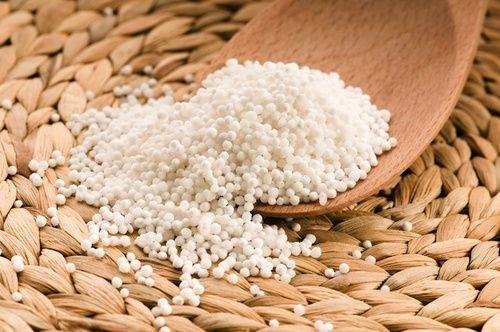, Naturopata
La tapioca is a starch obtained from the tubers of a tropical plant, the bitter cassava. With its great caloric value, tapioca has the quality of making milk more digestible and is useful for coliti and problems with the digestive system. Let's find out better.
> Nutritional characteristics
> How to use it

Description of the tapioca
Tapioca is one of the main foods of the indigenous people of South America and Equatorial Africa and has, in recent decades, also gained an important place in the European diet, due to its dietary characteristics.
It is a food nutritious and easily digestible which has proved very useful in diets for children and convalescents. It is in fact a rich source of calories, very similar to the justly famous rice cream, with which baby food and soups are prepared for the most delicate stomachs.
The procedure to obtain tapioca flour from cassava roots it is quite laborious: the edible starch, which constitutes the useful part, is in fact originally mixed in the roots with a milky juice which also contains prussic acid and other poisonous substances.
To prepare tapioca, therefore, it is necessary to separate the starch from the latex and from harmful woody substances. For this purpose the tubers are grated and collected in bags, from which the milky liquid is allowed to drain. Subsequently, the mass of grated tapioca roots is further washed and squeezed and, finally, dried, crushed and sieved, until it is reduced to a powder.
This starch is then partially cooked on metal plates heated to over 100 °, in order to break the starch granules of which it is composed: at this point the tapioca is ready.
With it, in tropical countries, bread is made, using it exactly as it is done with wheat in temperate regions. The small starch granules of the tapioca then have the power to swell. In fact, when cooked in water, tapioca acquires a characteristic gelatinous consistency. It is therefore widely used by the natives also in the preparation of soups, enriched with wild berries, pieces of meat, fish, etc.
Nutritional characteristics of tapioca
Tapioca powder, with an off-white color, is made up of very small, hard and multifaceted grains of starch. It dissolves completely, with boiling, in water, broths and milk, becoming viscous and transparent and acquiring a rather insipid sweetish taste.
Tapioca has a great calorific value, practically the same as that of wheat: a hectogram of this starch provides about 350 calories.
However, it is inferior to wheat as a complex of nutritional qualities, as it does not contain protein substances, vitamins, or mineral salts.
It is in fact a food composed almost exclusively of carbohydrates (starch), in the percentage of 87%. Precisely for this reason, however, tapioca has undoubted advantages, especially for the digestive system.
It is extremely easy to digest, because it has very little waste. Its cellulose content (a plant substance that is not dissolved in stomach) is in fact negligible (2,5%) compared, for example, to that of wheat, which is around 10%. Its assimilation therefore takes place quickly and completely. Leaving no residue, it is very useful in all diseases of thedigestive system, including colitis.
You can delve into all the ailments and natural remedies for the stomach

Properties of tapioca
An important property of tapioca starch is that of make milk more digestible. In fact, when tapioca is cooked in this food, the starch granules swell and, due to their structure, form a kind of network that disperses the casein contained in the milk: in this way the gastric juices can more easily attack and digest it.
Tapioca cooked in milk is very useful in the nutrition of children and infants with digestive difficulties, and of all people who need an overeating and therefore an assimilation that is as facilitated as possible. To these positive qualities, however, tapioca soups contrast their extreme poverty in proteins and mineral salts. They cannot therefore constitute an exclusive food, but must be associated in the diet with substances rich in proteins, fats and vitamins.
How tapioca is used
The real tapioca, that is the starch obtained from cassava roots, comes exclusively from tropical countries, where this plant is grown. Although the export of tapioca flour is huge to every country in the world, it is quite difficult, especially in Europe, to find original tapioca. Different types of tapioca are thus produced locally, which can only be distinguished from true tapioca by microscopic examination, due to the particular conformation of the starch granules.
The most popular tapioches in Europe are prepared with local flours (rice or wheat) or with potato flour. The dietary qualities remain practically the same, both for the composition and for the caloric intake. The only significant differences may concern some nuances of flavor, which however, for this food which is not excessively tasty, are of little importance.
Ideal foods to accompany tapioca porridges, completing them, are eggs, milk and cheeses. Tapioca starch is therefore highly recommended to enrich and thicken broths, soups and vegetable purees, giving them a much higher energy value, without weighing on the stomach.
Its use should be applied broadly, as well as to children, to all sick and convalescents, for whom it constitutes a pleasant and light ration of carbohydrates. The only ones contraindications for tapioca they are the diabetes (starch is made of glucose, like sugar) e obesity, in which there is obviously no need for an extra calorie intake.
READ MORE
Proper nutrition and foods to avoid in case of diabetes
Other articles on tapioca:
> Tapioca among gluten-free cereals: discover the others
> Properties and use of tapioca flour


























